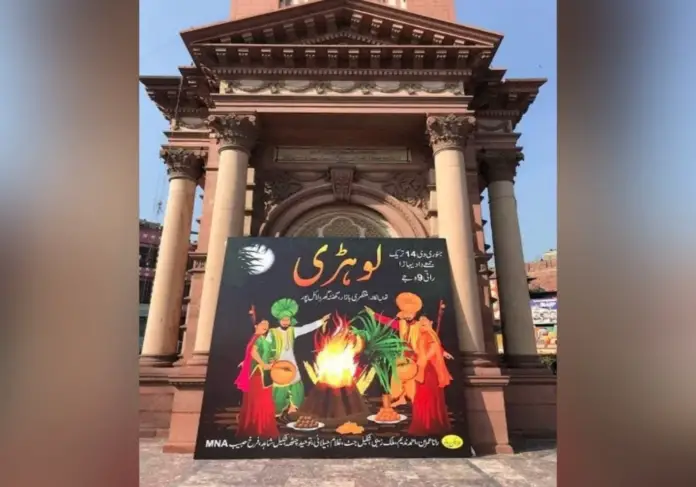Right now, the idea about Lohri, which is being celebrated today in Punjab across the subcontinental divide – has everything to do with campfires, elaborate victuals, food baskets, and throbbing to the beat of the latest bestselling music. However, how many of us know about the customary sense of hallowed campfire and the reason for people encircling it after sundown?
Actually, it has a more serious sense that is related to being grateful to the lord and dancing to the tunes of the dhol and relishing a delicious repast. It is a celebration that is part of Punjab and largely honoured in North India. For this occasion, victuals like til (sesame seeds), gajak (dry sweet made of sesame seeds or peanuts and jaggery), gur (cane sugar), peanuts and corn kernels are offered to the fire in a practice, which is an ingredient of the harvest. Lohri is also connected to the ‘Hibernal Solstice’ – the smallest day and the lengthiest night. In reality, this indicates the conclusion of winter and arrival of spring. There are other essential things that one must be aware of regarding Lohri, especially on the Pakistani side of Punjab.
The Idea of Lohri
A lot of us may not know that the word Lohri derives from ‘Tilohri’, that is ‘til’ implying sesame and ‘rorhi’ meaning cane sugar. Finally, the celebration came to be known as plain Lohri. Both of these food substances reportedly help sanitize the body, arriving with fresh vitality for the coming year. This is the reason victuals like cane sugar, gajak, chikki (brittle) are fed to the fire as a means to being thankful to mother Earth. It is also dedicated to Dulla Bhatti, a Muslim chieftain of the 16th century who became a legend and is said to have saved a Hindu woman’s honour on this day. In fact one of the Lohri ditties gives thanks to Bhatti for his rescue in the following words:
‘Sunder mundriye ho!
Tera kaun vicharaa ho!
Dullah Bhatti walla ho!
Dullhe di dhee vyayae ho!
Ser shakkar payee ho!
Kudi da laal pathaka ho!
Kudi da saalu paata ho!
Salu kaun samete!
Chacha gali dese!
Chache choori kutti! zamidara lutti!
Zamindaar sudhaye!
Bum Bum bhole aaye!
Ek bhola reh gaya!
Sipahee far ke lai gaya!
Sipahee ne mari itt!
Paanvey ro te paanvey pitt!
Sanoo de de Lohri, te teri jeeve jodi!
(Laugh, cry or howl!)’
(Beautiful girl
Who will think about you
Dulla of the Bhatti clan will
Dulla’s daughter got married
He gave one ser of sugar!
The girl is wearing a red suit!
But her shawl is torn!
Who will stitch her shawl?!
The uncle made choori!
The landlords looted it!
Landlords are beaten up!
Lots of simple-headed boys came!
One simpleton got left behind!
The soldier arrested him!
The soldier hit him with a brick!
(Cry or howl)!
Give us Lohri, long live your pair (to a married couple)!
Whether you cry, or bang your head later!)
Significance of campfire
Feeding victuals to the deity of fire on this day reportedly helps remove gloom from life and is a harbinger of success. In this matter, the campfire stands for the god of fire, Agni. After feeding victuals to the god, folk look for favours, success and joy from Agni.
Circling the campfire
Reportedly if one circles the campfire on Lohri day, it helps to bring success. In Punjab, this occasion signifies an extraordinary worth for newlywed girls. A lot of believers think that their invocations and anxieties will be responded to at once and life will be replete with favour.
Celebration of harvest
Lohri indicates the coming year for Punjabi peasants. On this day, the peasants supplicate and display their thanks for their yields prior to the start of harvesting and invoke Agni to favour their earth with plenty. They recite ‘Aadar aye dilather jaye’, that is, ‘May honor arrive and misery disappear’ while circling the fire.
The spell of winter victuals
No talk of Lohri is complete without winter victuals, which are prepared and toasted on Lohri. The customary Punjabi menu for Lohri consists of sarson ka saag (mustard) and makki di roti (maize bread), til ki barfi, gur ki roti (bread made from cane sugar), makhane ki kheer (sweet rice pudding made from fox nuts), panjiri, pinni (round ball-shaped sweets), til laddoo, gondh laddoo (laddoos made from edible gum) and more delicacies.
So a happy Lohri to all readers, especially from Punjab, and to all those who are celebrating. Celebrate generously and protect liberally!








Comments are closed.